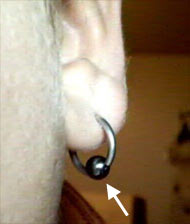Hematite: Difference between revisions
No edit summary |
No edit summary |
||
| Line 4: | Line 4: | ||
Iron oxide commonly used for beads | Iron oxide commonly used for beads | ||
Due to their pleasing appearance and low cost, hematite beads are commonly used on captive bead rings. Hematite is iron oxide - essentially a relatively inert silver gray/black form of rust. While it's perfectly safe to wear hematite as a bead, it is not recommended for subcutaneous use.<html><div class="mw-content-ltr" dir="ltr" id="mw-content-text" lang="en"><div class="floatright"><a class="image" href="/index.php?title=File:Hematite.jpg"><img alt="Hematite.jpg" height="224" src="/images/a/ae/Hematite.jpg" width="190"/></a></div> | Due to their pleasing appearance and low cost, hematite beads are commonly used on captive bead rings. Hematite is iron oxide - essentially a relatively inert silver gray/black form of rust. While it's perfectly safe to wear hematite as a bead, it is not recommended for subcutaneous use.<html><div class="mw-content-ltr" dir="ltr" id="mw-content-text" lang="en"><div class="floatright"><a class="image" href="/index.php?title=File:Hematite.jpg"><img alt="Hematite.jpg" height="224" src="/images/a/ae/Hematite.jpg" width="190"/></a></div> | ||
<p><b>Iron oxide commonly used for beads</b> | |||
</p><p>Due to their pleasing appearance and low cost, hematite beads are commonly used on <a href="/index.php?title=Captive_Bead_Ring" title="Captive Bead Ring">captive bead rings</a>. Hematite is iron oxide - essentially a relatively inert silver gray/black form of <i>rust</i>. While it's perfectly safe to wear hematite as a bead, it is not recommended for subcutaneous use. | |||
</p> | |||
</div></html><html><div class="mw-content-ltr" dir="ltr" id="mw-content-text" lang="en"><div class="floatright"><a class="image" href="/index.php?title=File:Hematite.jpg"><img alt="Hematite.jpg" height="224" src="/images/a/ae/Hematite.jpg" width="190"/></a></div> | |||
<p><b>Iron oxide commonly used for beads</b> | <p><b>Iron oxide commonly used for beads</b> | ||
</p><p>Due to their pleasing appearance and low cost, hematite beads are commonly used on <a href="/index.php?title=Captive_Bead_Ring" title="Captive Bead Ring">captive bead rings</a>. Hematite is iron oxide - essentially a relatively inert silver gray/black form of <i>rust</i>. While it's perfectly safe to wear hematite as a bead, it is not recommended for subcutaneous use. | </p><p>Due to their pleasing appearance and low cost, hematite beads are commonly used on <a href="/index.php?title=Captive_Bead_Ring" title="Captive Bead Ring">captive bead rings</a>. Hematite is iron oxide - essentially a relatively inert silver gray/black form of <i>rust</i>. While it's perfectly safe to wear hematite as a bead, it is not recommended for subcutaneous use. | ||
Latest revision as of 01:33, 21 May 2023
Iron oxide commonly used for beads Due to their pleasing appearance and low cost, hematite beads are commonly used on captive bead rings. Hematite is iron oxide - essentially a relatively inert silver gray/black form of rust. While it's perfectly safe to wear hematite as a bead, it is not recommended for subcutaneous use.
Iron oxide commonly used for beads
Due to their pleasing appearance and low cost, hematite beads are commonly used on captive bead rings. Hematite is iron oxide - essentially a relatively inert silver gray/black form of rust. While it's perfectly safe to wear hematite as a bead, it is not recommended for subcutaneous use.
Iron oxide commonly used for beads
Due to their pleasing appearance and low cost, hematite beads are commonly used on captive bead rings. Hematite is iron oxide - essentially a relatively inert silver gray/black form of rust. While it's perfectly safe to wear hematite as a bead, it is not recommended for subcutaneous use.
